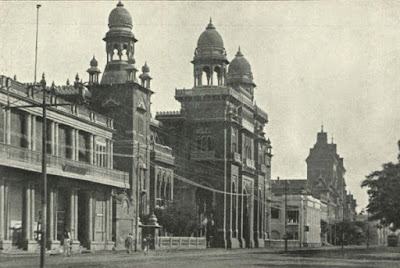 |
| Bank of Madras building, Chennai 1900s bank.sbi |
The capital of Tamil Nadu, Chennai (Madras) has countless European-style buildings which still remind us of colonial legacy and glory. Many of them are fairly preserved and some need proper care and attention. Despite the march of time and vagaries of weather that will normally impact the old structures, here in Chennai, the old British buildings have not yet lost their charm and beauty. They stand apart among the cluster of new concrete structures surrounding them. One of the Victorian-style buildings is what was then called Bank of Madras building.
 |
| Chennai map. Maps of India |
 |
| The Bank of Madras, c. 1905,en.wikipedia.org |
The credit goes to Governor William Gyfford (1681-1687), who in 1683, established a bank upon consultation with his council. A Finance Committee was formed in 1805 on the recommendation of Gov. Sir William Bentinck and it recommended the establishment of first government bank in colonial India under the East India company rule. Thus Bank of Madras came into being which took over Lord Krishna Bank; it began functioning from 1 February 1806. In the early stages, the bank was operating from the Exchange Building (that houses the present Fort Museum within Fort St. George). Being a joint stock company founded in 1843, the initial capital was Rs 3 million with the merging of Madras Bank, Carnatic Bank (1788), the British Bank of Madras (1795), and the Asiatic Bank (1804). The Bank of Madras had a net work of many branches covering major cities and towns across the Presidency (all southern states).
 |
| Bank of Madras building, Chennai. www.tribuneindia.com |
In 1897 as the necessity arose the Head office was shifted to a new building on South Beach Road, Madras. A sum of Rs.100000.00 was spent on the plot and the building was designed by Col. Samuel Jacob, a famous architect well-known in Colonial India. Later, it was re-modified by Henry Irwin (1841-1922). The construction work was given to a reputed Indian builder Namperumal Chetty and the total cost was Rs.300000.00. This impressive old structure is a good example of Victorian style building in the heart of Chennai city.









